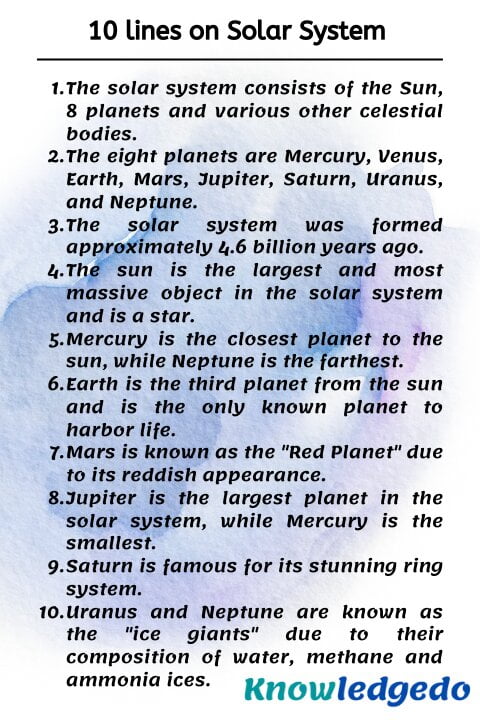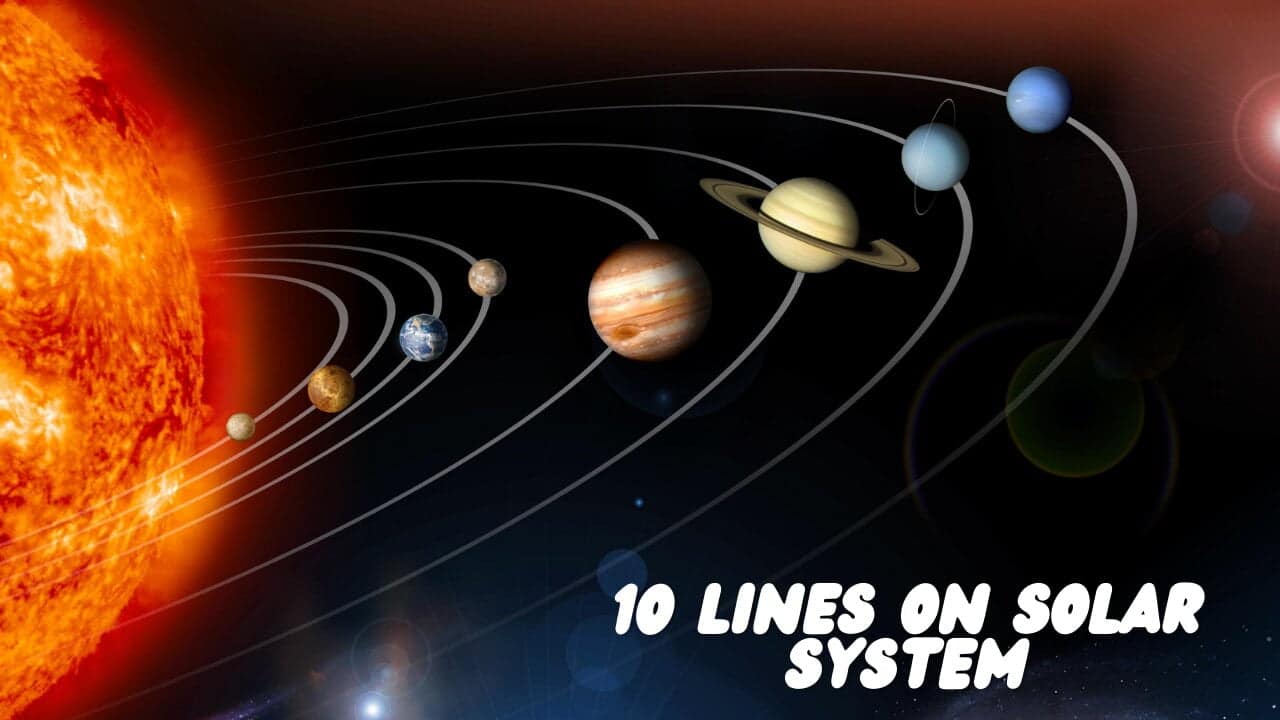Today, we are sharing 10 lines on Solar System in English. This article can help students who are looking for information about 10 lines on Solar System. This essay is very simple and easy to remember. The level of this essay is moderate so any student can write on this topic.
This article is generally useful for class 1,class 2,class 3,class 4,class 5,class 6,class 7,class 8,class 9,class 10,class 11,class 12
10 lines on Solar System
1) The solar system consists of the Sun, 8 planets and various other celestial bodies.
2) The eight planets are Mercury, Venus, Earth, Mars, Jupiter, Saturn, Uranus, and Neptune.
3) The solar system was formed approximately 4.6 billion years ago.
4) The sun is the largest and most massive object in the solar system and is a star.
5) Mercury is the closest planet to the sun, while Neptune is the farthest.
6) Earth is the third planet from the sun and is the only known planet to harbour life.
7) Mars is known as the “Red Planet” due to its reddish appearance.
8) Jupiter is the largest planet in the solar system, while Mercury is the smallest.
9) Saturn is famous for its stunning ring system.
10) Uranus and Neptune are known as the “ice giants” due to their composition of water, methane and ammonia ice.

10 lines on Solar system (set-2)
1) The solar system is comprised of the Sun and all the objects that orbit it, including planets, moons, asteroids, and comets.
2) The eight planets in the solar system are Mercury, Venus, Earth, Mars, Jupiter, Saturn, Uranus, and Neptune.
3) The solar system was formed about 4.6 billion years ago from a cloud of gas and dust.
4) The sun is the centre of the solar system and provides heat and light to all the planets.
5) Each planet in the solar system has its own unique characteristics, such as size, atmosphere, and geological features.
6) Earth is the only planet known to support life, with a diverse array of plants, animals, and microorganisms.
7) The four inner planets, Mercury, Venus, Earth, and Mars, are called the “terrestrial” planets due to their rocky compositions.
8) The four outer planets, Jupiter, Saturn, Uranus, and Neptune, are called the “gas giants” because of their large size and gaseous compositions.
9) The asteroid belt between Mars and Jupiter contains many small rocky objects left over from the formation of the solar system.
10) The Kuiper Belt is a region beyond Neptune that contains many small icy objects, including dwarf planets such as Pluto.
5 lines on Solar system
1) The solar system consists of the Sun and all the celestial bodies that orbit around it.
2) It contains 8 planets, namely Mercury, Venus, Earth, Mars, Jupiter, Saturn, Uranus, and Neptune.
3) The Sun is the largest and most massive object in the solar system and provides heat and light to all the planets.
4) Earth is the only planet known to support life.
5) The solar system was formed about 4.6 billion years ago from a cloud of gas and dust.
FAQ on Solar system
Answer: The solar system is comprised of the Sun and all the objects that orbit it, including planets, moons, asteroids, and comets.
Answer: There are 8 planets in the solar system, they are Mercury, Venus, Earth, Mars, Jupiter, Saturn, Uranus, and Neptune.
Answer: The solar system was formed about 4.6 billion years ago from a cloud of gas and dust, known as the solar nebula, which eventually coalesced into the Sun and the planets. The exact process of formation is still being studied by astronomers and scientists.
